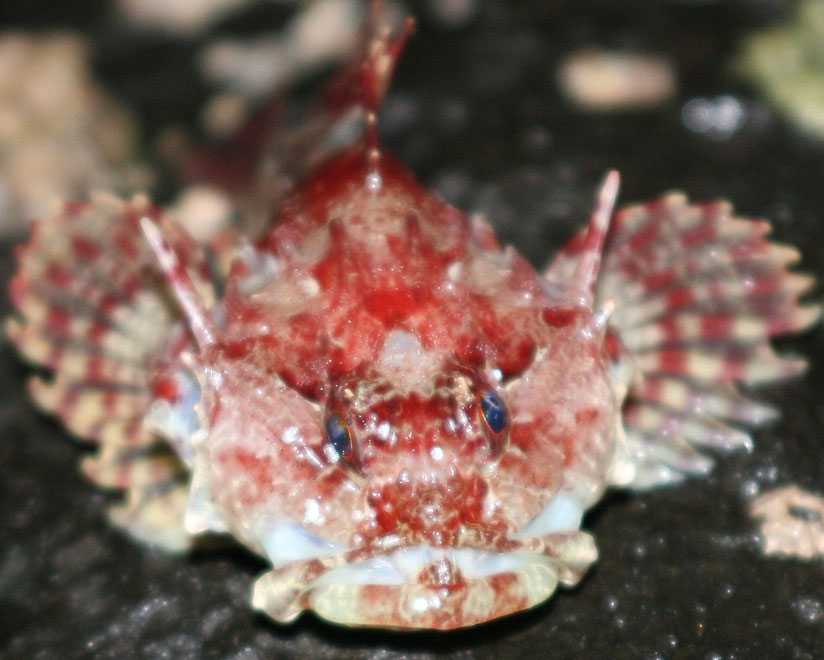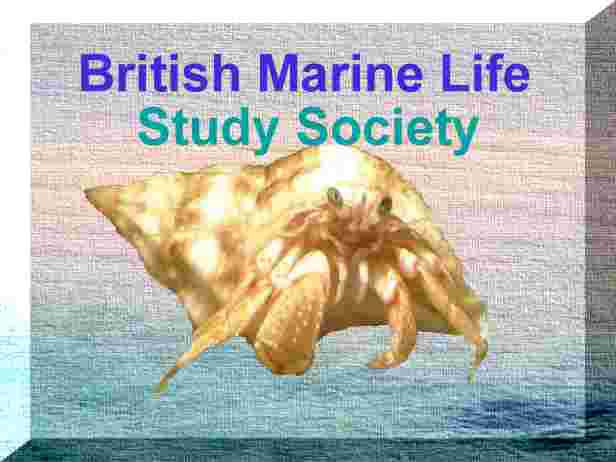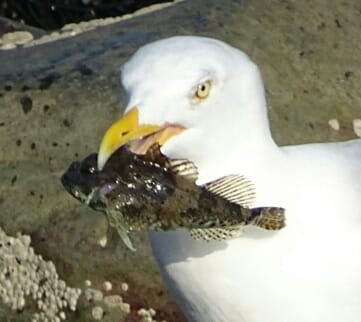Identification:
A small fish with a stout
body (flattened out wide about the same as it is high) with a head as large
as the rest of its tapering body. Medium-sized cottid, or sculpin. This
family of fish are usually regarded as ugly in appearance with a drab colour
and this species has four long spines (two on each side, on the gill cover)
that stick out when the fish is removed from the water. Usually in various
shades of brown with large cream blotches, in some areas this fish will
be orange or red and the cream blotches will be white. The pectoral fins
are huge relative to the small squat body.
The featured species can
also be reddish (picture in Linda
Pitkin's book) and then the flaps at the corner of the mouth should
be looked for.
I
think these fish will darken or lighten over a short time (an hour?) to
match their environment. AH
Similar species: Myoxocephalus
scorpius is very similar in appearance. However, the two species
can be readily distinguished because only T. bubalis has two white
lappets on the corners of its wide mouth.
 Taurulus
bubalis Taurulus
bubalis
The Norway
Bullhead, Taurulus lilljeborgi, is found in deeper water off the
coasts of Scotland and Norway. It is usually reddish in colour with similar
markings, and the long spines on each gill cover are almost identical.
A photograph can be found on the Norwegian
web site.
Link
to a photograph of Taurulus lilljeborgi by
Espen Rekdal
Bullhead
Taurulus
bubalis demonstrating how bright colours can be camouflage (Link).
Photographed
at Tjärnö
Aquarium by Mike Noren.
Photograph
(overhead view) by Nicolas Jouault
Terror
of the Rock Pool (article)

Red
specimen from Bangor Pier, County Down, Northern Ireland. There are piles
of boulders along the back of the pier as a sea defence with massive gaps
in between them. I would normally fish down between these to see what species
of fish are about. All sorts turn up .
Photograph
by Ronald
Breeding:
Early spring. Small clumps
of cream caviar-sized eggs laid in shallow water.
At
a length of approx. 8.2 mm (excluding caudal fin), the dorsal fins of the
larvae are clearly separated, the first dorsal with 8 ray supports, the
head completely pigmented, the body and fins transparent, and found amongst
the weed in a shore pool, (one specimen) at Kingston beach, Shoreham on
13
May 2001.
| In
the wild, Bullheads spawn in Spring, from February to May, at the end of
their second year. Breeding should be possible in a large aquarium.
Photograph
by Sarah
Sheeran: Eggs of Taurulus
bubalis on the underside of a decorated
rock |
 |
Habitat:
Shallow rocky areas. Small
fish will be found in tide pools during the summer. M. scorpius lives
in deeper water.
Food:
A large expandable mouth
will swallow fish as big as itself. Flattened crushing teeth so it cannot
eat anything it cannot swallow whole. In the English Channel, palaemonid
prawns are its principal diet in the summer. It will readily take worms
on a hook and bait meant for much larger fish.
Known to eat small gobies,
small blennies and small wrasse, but not the
Butterfish,
Pholis gunnellus. The Butterfish
is too slippery for it to grip with its teeth.
I
saw
the large bullhead eating a smaller one, head first, the large fish was
on the resting (?) on the bottom, with the smaller one's tail, sticking
out. I did not see the attack. There were four bullheads in the tank when
I saw it first. Ten days later there were two, and one was being eaten!
Peter
Biddulph
Range:
All rocky coasts around
the British Isles. Its range in Scotland is not known and may be
replaced by M. scorpius.
Norwegian coast.
English Channel, North Sea,
Irish Sea.
Locations:
Kingston
Beach, Shoreham-by-Sea (very common)
Cremyll Point, Devonport
(Report
by Lee Massey, Andover, Hants)
Enemies:
Larger
fish, sea birds, Otters.
27
September 2007

Eider
Duck Somateria
mollissima
swallowing
a Bullhead
Photograph
by Dave Pullan
Eider
Ducks usually eat mussels and perhaps other
molluscs
so
this is a most extraordinary photograph.
Dave
Pullan Photographic Portfolio
Parasites/Commensals:
Isopods,
family Gnathiidae (gnathids). Species:
Gnathia sp. The young of
these isopods are called pranizae.
The
parasite on Sue Daley's Taurulus bubalis is a male Anilocra
frontalis
(a cymothoid isopod.) These isopods are common on Black
Sea Bream in Guernsey waters during the winter months. I have
recorded them also on wrasse, Poor Cod and Red Mullet.
I
have been surveying a small rocky bay, La Valette, near my home in Guernsey.
I have visited it at least 20 times since March when I was introduced to
the bay by a group of Nottingham University students.
I found
also a small Long-spined Sea Scorpion,
Taurulus
bubalis, (TL 61 mm) at the midshore level in a gully. I placed
it in a tray for photography. As I did this I noticed 5 or 6 blue-green
bodied creatures dashing around in the water. These turned out to
be juvenile gnathids. They are pranizae. They are bright blue-green
and well camouflaged on the sea scorpion. I have developed my photos
of the sea scorpion and I can clearly see the pranizae on the pectoral
fins and body of the fish.
More
parasites/commensals:
Isopods:
Caligus
elongatus
Leeches:
Calliobdella
punctata (20 mm long)
Malmiana
bubali (12 mm)
Malminan
yorkii
Oceanobdella
microstoma
Sanguinothus
pinnarum (7 - 12 mm)
Gnathia
isopods
Oceanobdella
microstoma on Taurulus bubalis (Bullhead or Sea Scoprpion);
just confirmed by Gene Burreson. The leeches are on approx 1 in 3 Bullheads
at Penzance at the moment.(March 2012) Report by David Fenwick
Additional
Notes:
The
book name of Sea Scorpion may be used by divers.
The
common name Longhorn Sculpin (USA) is sometimes used for the western Atlantic
species Myoxocephalus octodecemspinosus
so this name has been deleted
from the list of common names.
Growth:
one female in captivity grew to a length of 14 cm (excluding the tail fin)
by the second summer. In this specimen the width of the mouth opening was
35 mm (exterior of the mouth was 40 mm, excluding the 2 lappets which are
unclear out of the water), the diameter of the eyes 8 mm, the length of
the longest slightly curved spine was 17 mm. The width of this fish at
the widest point was 58 mm (i.e. it was 2.4 times longer than it was wide
at the position of the gills). Growth is usually less and males may
even grow to less than 8 cm in length by the second summer.
More
information
Large fish have high oxygen
requirements and are intolerant of temperatures over 22°C. However,
the first year juvenile fish (that are common in rock pools) are able to
tolerate temperatures up to 26°C in the short term (aquarium
study).
Reports:
Large
numbers of juvenile fish (first year) have been found on occasions with
hollowed bellies as though they had insufficient food in silty conditions
(River Adur estuary).
Largish
specimens, 10 cm, intertidally on the Scarborough coast (March 2000).
Bullheads caught regularly
off Roker pier, Sunderland (NE England), 125 - 200 mm.
A
reddish-brown, but predominantly red, specimen of what was almost certainly
this fish was captured in a prawn net by Dean
Tucker (Solihull) on at Challabrough beach south Devon on the 30th
July 2000. This is the next beach along from Bigbury Bay.
A
small Bullhead with a rust-like tinge over its body was collected from
Kingston
beach, Shoreham, in October 2000, for its photograph. However, within
one week this rust-like tinge had disappeared.
AH.
January
2001
Several
hundred Long-spined Bullheads were found up washed on the strandline on
Lancing beach at the western end of Widewater Lagoon,
West Sussex. This has has not been recorded before.
We found
a Long-spined Bullhead in a rockpool on Porthmeor Beach in St. Ives in
Cornwall on the 10 August 2001.
The fish was found by Emma and Joe Yapp and was about 15 cm long.
It was identified by its big head and 2 white lappets on the corners of
its mouth.
Emma
and Joe Yapp
Four
Bullheads, Taurulus bubalis, found on Caswell Bay (all in one pool),
Gower, South Wales - 1st of September 2001.
Identified by shape, coloration and lappets by Adam
Cooper (Swansea).
29
September 2001
An interesting description
of a Bullhead caught by an angler (a typical response, but well written):
Whilst fishing on Saturday
(29/09/01) my partner (Caroline Mabb) pulled
out a fish which looks a lot like the picture at the top of the page:
We are fairly new to sea
angling and this thing came as a bit of a surprise - it looked so ugly
that we though it must be dangerous so I was given the task of unhooking
it : After being gently wrapped in a moist tea-towel (I didn't like
the look of the spiny fins) and unhooked it was returned successfully and
swam off looking none the worse for it's adventure.
Date/Time: Saturday
29th Sept, 2001. About 4.30pm.
Location: We were
fishing on the pier at Blythe, about 20 yds past the dogleg (the pier turns
a corner on its way out to sea).
Tackle (just in case you
are interested): A float setup was fished in amongst the pilings
of the pier. Bait was fished at a depth of around 6 feet (I don't
know exactly how deep the water was but assume this was fairly near the
bottom). A number 1/0 sized hook was used.
Bait: A smallish ragworm
was threaded up the shank of the hook, which was tipped off with a chunk
of frozen mackerel. The fish had fully engulfed the mackerel.
So why do I think it was
a bullhead? To be honest I simply do not have a
clue what it is (the reason
I looked at the website). We at first thought
it might have a been a Weever
but I had never caught one of those either so
we were really in the dark.
Looking at the photos on the site the bullhead
seemed to be about the closest,
although it was not a perfect match for the
picture shown. It
definitely was not a weever though as it looks nothing
like any pics I can find
of those.
The arrangement of fins matches
that shown, two fairly large fins with a
curved profile were visible
on the back. Large pectoral fins with the
same curved profile stuck
out just behind the gills. When the fish was
lying on its belly it appeared
that the front fins supported it slightly off
the ground. The eyes
were large and bulbous, protruding above the profile
of the skull. The
skin from what I recall appeared rough (slightly
toadlike) and was a very
dark brown colour, having slightly lighter brown
mottling (which may have
contributed to the roughened appearance of the
skin. Certainly it
was not as light in colour as the picture shown.
Sizewise the fish was about
12 cm in length. The underside of the fish was a
whitish colour and either
side of the belly there appeared to be a pair of
spines, possibly fins -
I didn't fancy getting too close to inspect and
wanted to get the fish back
in the water ASAP so didn't spend much time
checking.
I am afraid that is about
it. Unfortunately I do not have a picture as we
were camera-less which is
a real shame, as I guess it would have settled the
debate for good. If
you can confirm from my descriptions what Caroline
caught we'd love to hear
about it. I'm also interested to know why you are
interested to know about
bullheads.
Jonathan
Harris
20
October 2001
D.Allen
found a Long-spined Bullhead on Swanpool Beach, Cornwall.

18 November
2001
A
Sea Scorpion (Bullhead), shown in the photograph above, with strong colours
and patches of white, on the undersea chalk cliff face known as the Worthing
Lumps, about 3 miles off the Sussex coast.
16
February 2002
I fished with some friends
Saturday night on Llandudno pier, north Wales, we were getting knocks but
failing to connect, we were fishing the bay side of the pier where it broadens
out at the end, casting into an area illuminated by a floodlight, the tide
runs at an angle from shore directly under the wing of the pier, and is
quite fast and strong. My friend Geoff pulled in a fish, which yes frightened
the life out of us, and we have been trying to identify it which is why
I was looking at this sight.
The fish we caught, he went
on to catch a second one an hour later! fits the general description of
the Bullhead but does vary in coloration and I question size.
Here goes, without the histrionics,
first impression was of the mechanical fish from stingray!, sorry but it
was night time and the thing was bloody ugly, but its coloration was fantastic,
which led us to be convinced it was poisonous!
The fish was at least 18
cm long, general appearance of the bullhead, large flattened head covered
in nodules, not unlike the blyth angles description of a toad like appearance,
dull green in colour, the mouth was huge for the size of fish curving round
the sides of its massive flattened head, the mouth underside and slightly
above was iridescent white, but with distinct blue colouring in places,
which merged and faded into the white, it looked like a schoolchild that
had been sucking on a leaking blue pen. The pectoral fins were extremely
large and splayed in an aggressive manner, they were banded in alternate
red and white, quite a deep red, with much smaller lines of white, it had
a spinned front dorsal which it raised perch like and was spend along its
entire length, no coloration, the second dorsal was much lower and longer
stretching down to almost its tail fin. The body was thin,
compared to the head and
was iridescent white with brown spots, the spots where distinctive and
had a lighter aura effect at outer edges.
Both fish showed the same
blue tinges, some quite dark but merging into the whiteness of the body,
i.e. fading, this was mainly from below the fish spreading down the body
to the tail, these seemed irregular, i.e. not the same on both fish. There
may have been secondary spines/rays slightly behind the large pectorals,
i.e. like damaged fins. The fish both took mackerel and squid cocktail
baits, on size 1/0 hooks. Both fish were unhooked by myself, I found the
best technique was to lightly grip the upper mouth with pliers and remove
the hook with surgical forceps, sounds horrendous but we wanted to avoid
the spines and wrapping the fish to avoid these would have resulted in
removing any mucous and possible damaging the skin. The fish seemed to
prefer this method which was quick, the upper mouth appeared very strong
in terms of bone construction so grip was easy and did not require a lot
of pressure. both fish were immediately released and swam away strongly.
What were they? as i say
they did not match the coloration of the Bullhead, and were big, can you
help. A Middlesborough angler told us they were Scorpionfish, no one else
including local anglers had never encountered anything like them before.
Sorry not a very scientific
report! Howard Lawton

30
March 2002
Bullhead at Lancing
Beach
Adur
Wildlife Report (Link)
8 June
2002
Pillar
box red Bullhead caught on a ragworm bait from Roker Pier, Sunderland
by Mark Scott. It was about 15 cm long (including
the large caudal fin).
23
June 2002
Caught a Sea Scorpion at
Tide Mills, Seaford, Sussex at approx
21:00. HT 22:00. Approx
size 15 cm (6 inches). Colour: pinkish red with cream.
10
January 2003
I caught a Bullhead
off the beach at Llanrhystud, 9 miles south of Aberystwyth, Wales (Cardigan
Bay) using Mackerel bait. I wasn't sure what
it was as I've never seen one before several other fishermen who
were there couldn't decide wether it was a Bullhead or a Weever
fish I looked it up when I got home and it was the Bullhead. My book calls
it a Sea Scorpion.
10
July 2005

We visited
West Runton coast and saw these two fish they were about 4 inches long
and in the rock pools, and we have been looking
on the net to find out what they were. This is when we came across your
site and wonder if they are Cottidae or the T. bubalis
.
This study
shows how effective the camouflage of this fish in pools on the shore and
in the shallow water.


6 October
2007
This
attractive red Long-spined
Bullhead latched on to the bait on my
friend's fishing line (without swallowing the hook) and was returned alive
to the sea off the east coast of Northern Ireland (just north of Tornamoney
Point, which is just north of the village of Cushendun
in NE County Antrim).
The
white lappets in the corner of the mouth cannot be seen clearly in this
fish.
Reports
and Photographs by Cathal McNaughton
-------------------------------------------------------------------------------------------------------------
Information wanted: Please
send any records of this fish, with location, date, who discovered it,
how it was identified, prevalence, common name and any other details to
Shorewatch
Project  EMail
Glaucus@hotmail.com. EMail
Glaucus@hotmail.com.
All messages will receive
a reply.
|













